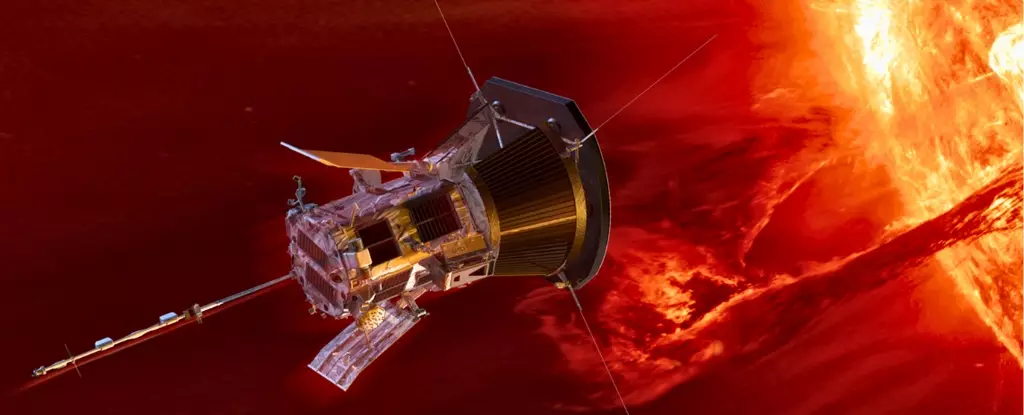In a landmark achievement for solar science, NASA’s Parker Solar Probe (PSP) has embarked on an unprecedented mission to study the Sun. Launched in August 2018, this innovative spacecraft aims not just to observe our star from afar but to make close encounters with its outer corona, a region of the Sun’s atmosphere that has long eluded detailed scientific exploration. Thanks to a series of gravity-assist maneuvers around Venus, the Parker Solar Probe has progressively moved into its highly elliptical orbit, culminating in its record-breaking proximity to the Sun, achieved on October 29, 2018. In the pursuit of knowledge, the scientific community now looks forward to the probe’s ongoing revelations about the Sun’s behavior, fundamentally reshaping our understanding of solar dynamics.
On December 24, 2024, the Parker Solar Probe made headlines again, as it executed a close approach to the Sun, coming within a mere 6 million kilometers (3.8 million miles) from its fiery surface. This distance is astoundingly about 0.04 astronomical units (AU)—a milestone that redefined how close humanity has ventured to a star. What’s more, the probe achieved staggering speeds during its approach, soaring at approximately 692,000 kilometers per hour (430,000 miles per hour). This feat positions the Parker Solar Probe as the fastest human-made object in history, an epitome of engineering ingenuity and ambition.
These close encounters provide a unique vantage point for scientific inquiry. The Parker Solar Probe does not merely passively observe; it actively collects data that could enrich our understanding of the solar wind—the stream of charged particles emitted from the Sun—and its implications for space weather affecting our technological infrastructure on Earth.
Innovative Technology for Extreme Environments
To withstand the inhospitable conditions of the Sun’s corona, the Parker Solar Probe is equipped with state-of-the-art technology, including a cutting-edge carbon-composite heat shield designed to endure temperatures reaching as high as 1,425 °C (2,600 °F). This remarkable shield not only protects the delicate instruments aboard but also maintains them at a stable operating temperature, allowing for accurate measurements and observations. Nicky Fox, Associate Administrator at NASA, termed this venture a historic milestone, highlighting the necessity of studying solar phenomena to understand broader astrophysical processes and their impacts on Earth’s technology.
The mission represents not just a technological triumph but a deeper quest for knowledge about stellar systems—an endeavor that can enhance our understanding of potential habitable worlds beyond our solar system.
The Parker Solar Probe’s journey is also inspiring a renaissance in solar research. Since its first encounter with the solar atmosphere, the spacecraft has revealed unexpected features, such as the surprising structure of the corona, characterized by spikes and valleys, contradicting prevailing theories. Furthermore, investigations have uncovered the origin of so-called “switchbacks”—zigzag patterns found in the solar wind, underlining the potential for ongoing discoveries to reshape our understanding of solar processes.
Beyond its primary focus on the Sun’s behavior, the Parker Solar Probe has also contributed to our understanding of planetary interactions within the solar system. The probe has documented the radio emissions from Venus and captured the first complete images of its orbital dust ring, enhancing our comprehension of planetary atmospheres and their surroundings.
Understanding space weather, the manifestations of solar activity like coronal mass ejections (CMEs), is critical not just for space exploration but also for our daily lives on Earth. The Parker Solar Probe has withstood multiple encounters with CMEs, gathering invaluable data that promises insights into how solar wind and solar flares interact with Earth’s magnetic field. Such research is vital for safeguarding technological systems that are increasingly sensitive to cosmic events.
According to Adam Szabo, NASA’s mission scientist, the ongoing data collection from the Parker Solar Probe will deepen our understanding of how solar wind accelerates, thus contributing to both theoretical astrophysics and practical applications in communication, navigation, and energy systems on Earth.
A Future Illuminated by Knowledge
As humanity stands at the precipice of a new era in space exploration, with the Parker Solar Probe at the forefront, the scientific community is eager to receive and analyze the treasure trove of data set to flow from the spacecraft in the coming months. The next solar passes are anticipated on March 22 and June 19, 2025, each promising to unveil more of the Sun’s intricate mechanisms. Joe Westlake from NASA encapsulates the excitement when he states that this mission represents a goldmine of fresh insights about areas previously shrouded in mystery. In our quest to decode the Sun’s secrets, the Parker Solar Probe heralds an exhilarating chapter in humanity’s exploration of the cosmos.


Leave a Reply